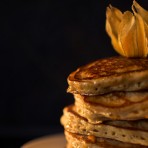
Have you ever tried kefir? When I first heard about it I’d keep getting it confused with *kaf*fir, which is a lime leaf used in many South East Asian dishes and I had a hard time imagining why people would be drinking this leaf… Anyways, once I got my spellings sorted out, I was fascinated to learn about the numerous and wonderful health benefits attached to making this tangy, yogurty drink called kefir part of your daily routine. However, life seemed to have this way of constantly diverting my moment’s focus and not giving this magical bacteria its proper attention. After seeing the high price tag of store-bought kefir and hearing about making it fresh for pennies a batch at home, all it took a little prompting from my girlfriends (thanks Nadine and Teresa) and a little late night research/surfing/YouTube-ing. What finally pushed me over the edge into kefir-making was a lovely offer by sweet Teresa to share her grains with me. Yay for friendship!
There is so much good information to read on kefir. Like here, here, and here.
But from a more personal perspective, here are some of my experiences -so far- with kefir:
1. The health benefits are by far the main reason that sold me. Besides being loaded with tons of probiotics, different from the ones in yogurt, vitamins and minerals, it also promotes bone, immune and digestive health.
2. The taste, described by many like a tangy, thinned out yogurt drink. Some cultures can produce more of a effervescent effect. The neat thing is that kefir seems to have it’s own “personality” that changes with temperature, space, humidity, and it’s general environment. My particular grains produce a more effervescent effect in coconut milk, and more yeasty tang in dairy milk.
3. Being that most of my family has varying levels of dairy intolerance, I was a bit skeptical that we’d be able to handle the diary kefir. However, my boys drink a cup daily without issue and even Dave can do a smoothie every now and then. I’ve read that the fermenting process eats up much of the lactose, but for those who are highly lactose intolerant, a non-dairy version is probably best.
4. There is a naturally occurring alcohol that is produced in kefir, usually less than 1%. If you are blessed with the Asian alcohol “glow” gene (meaning extremely low alcohol intolerance) like my husband, you may even feel the effects of this minute content. Dave reports faster heartbeat and flushed cheeks. Yeah, it’s a party at the Cheung house!
5. 90% of the time, I use my kefir in smoothies. The kids love them! Anyone interested in me sharing recipes, let me know. 🙂 Besides that it works great as a replacement for yogurt or buttermilk in any recipe. So everything from banana bread, to pancakes to really awesome caesar salad dressing. Yum!
6. My kefir grains have grown and multiplied so much I now keep two batches going: one with organic milk, and another with coconut milk. To ensure the health of my grains, I make sure to alternate milks each day, i.e. make sure the grains don’t stay exclusively in coconut milk because they need time in a dairy environment to stay healthy.
7. Kefir is for sharing! It’s always a good feeling to pass along something healthy and nutritious to your friends and family. So far I’ve shared my extra grains will all my close family near by. I may have to start giving them to the neighbours soon….
So here is a quick rundown of my process for making kefir everyday:
These are my lovely dairy-kefir grains. You only need about a tablespoon for a pint sized mason jar.
This is what a cultured batch of kefir looks like (grains are still inside). It’s been culturing for about 24 hours at 70 degrees F. Let’s strain out the grains.
A note on utensils: use a clean glass jar for each new batch. Stay away from plastic jars as they tend to breed unwanted bacteria. Do not use metal utensils as contact with metal will damage your grains, stick to plastic strainers and wooden spoons.
Gently pour and strain the cultured kefir through the plastic mesh.
Dump the strained grains into a clean glass jar.
Fill with 2% organic milk (try to avoid using skim as the grains need some fat to grow) or coconut milk.
Cover your new culturing batch with a coffee filter or paper towel, and store for the next 12-48 hours in your pantry, cupboard or countertop, out of direct sunlight.
If your ever see/smell anything funky in your kefir or grains, always do the smart thing and TOSS IT.
The ready to drink kefir can be stored in the fridge for 2-3 days.
If you’re already making kefir, I’d love to know how you’ve been enjoying yours!




















